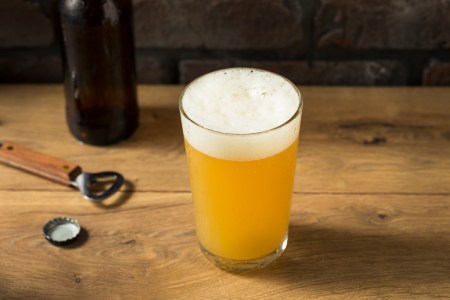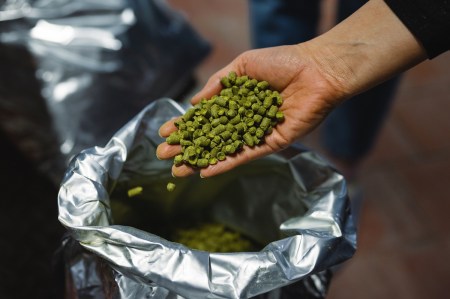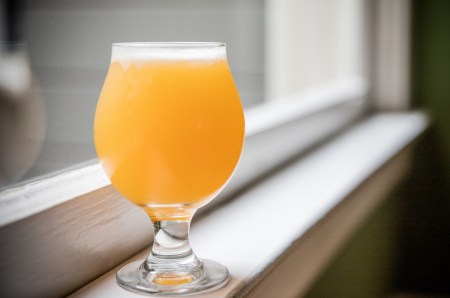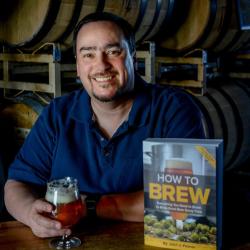
The Oat Cream IPA style was new to me, so for answers I called up Other Half Brewing Co. in Brooklyn, New York and spoke to one of the co-founders Sam Richardson. Other Half are one of this style’s pioneers and have been making Oat Cream IPAs for the past five years or so.
Sam said they grew out of the New England IPA style in the effort to deliver a smoother, creamy mouthfeel of hop flavour. I must say it was interesting talking to him. There really is a big coast to coast difference in IPAs here in the US. They are typically dry, bitter, and thirst quenching on the West Coast and round, full and pillowy on the East.
The key is in the malts
Both styles of IPA are known for their over-the-top hop aroma but it’s the malt character of the beers that set them apart.
A West Coast IPA is predominately 2 Row base malt, which is not as bready as Pilsner malt, but not as malty as Pale Ale malt. To that is added a touch of crystal malt, typically 2 to 5% of the grainbill, and then maybe another 2 to 5% of wheat malt or foam enhancing malt.
Ten years ago we would have described an East Coast IPA as a maltier, less bitter version of a WCIPA. But today’s versions are pervasively the New England IPA style – hazy with hop polyphenols that helps them retain more hop aroma and flavour than you would get with the same amount of hops in a WCIPA.
The base recipe for a NEIPA is typically: 70% base malt, 10% flaked Oats, 10% Wheat malt, 10% Caramel malt and then lots of whirlpool hops and dry hopping.
Other Half wanted to expand on this, to really pump up the mouthfeel by increasing the oats. They increased the oat malt and rolled oats percentages, backed off on the wheat and crystal, and then added lactose to boost the sweetness and tip the balance of the beer to make it more approachable despite being super hoppy.
The resulting grainbill morphed into an average of 60% base malt, 35% oats and the remaining 5% being variously composed of wheat malt, crystal malt, and lactose, with about 2% lactose being typical.
The oat part of the grainbill is typically a 2:1 ratio of rolled oats to oat malt. And for those that are wondering, 50% oats was the farthest they were able to push it, but they felt that they were not seeing any real improvement in the character of the beer past 35%, just more work in lautering.
The mash for these beers is generally a single infusion with a mash target of 67°C for maximum conversion and good fermentability. Even though the balance on these beers is slightly to the sweet (and really because of that), the fermentability of the wort is high because the lactose provides the unfermentable sugar.
Oat Cream ales can be made in Pale Ale, IPA, or Double IPA formats, 5%, 7%, or 9%, respectively. The grainbill percentages given above are consistent across these strengths. However, the hop schedules increase accordingly to help maintain balance.
While calculating IBUs can be difficult for whirlpool and dry hop additions can be hit or miss (mostly miss), the latest calculators from BeerSmith and others that include isomerisation as a function of temperature can help. In general, you would be targeting 30, 60, and 90 IBUs respectively for Pale, IPA, and Double IPA. But please understand that those numbers are based on the current IBU calculation models, like BeerSmith, and best serve as a measure of what you are putting into the wort, not what you are actually achieving in the beer.

The hopping guidelines are as follows:
For Pale Ale:
• No bittering addition
• Whirlpool addition of 2 to 4 grams per litre
• Dry hopping of 4 to 12 grams per litre
For IPA:
• 10 to 20 IBU bittering addition
• Whirlpool addition of 3 to 5 grams per litre
• Dry hopping of 10 to 30 grams per litre
For Double IPA:
• 20 to 30 IBU bittering addition
• Whirlpool addition of 4 to 8 grams per litre
• Dry hopping of 10 to 30 grams per litre.
For the hops
Use the fruitier varieties, and use high alpha/high oil as much as possible to minimise the green matter and hop bite. Achieving such high dry hopping rates as 10 grams per litre is difficult to say the least. Double dry hopping can help you achieve these rates, and the extra hop aroma, but be aware that every time you open the fermentor or the keg to dry hop, you are exposing the beer to oxygen and staling.
There isn’t room in this article to discuss all of the tips and tricks to minimise oxygen exposure, but purging the hops in a hop bag, and the headspace with CO2 before dry hopping is probably the best step forward.
The dry hops should be done cool, anywhere from serving to cellar temperatures (3 to 10°C), for two days (three days max) before pulling the hop bag and replacing it with another. More than two dry hops is not recommended due to oxygen exposure. And please, drink these beers fresh!
Brew day
These instructions are designed for a brew in a bag (BIAB) setup. The crushed grains are placed in a large nylon mesh bag and mashed (steeped) in the brewing water for one hour. After that, the bag is lifted out of the mash tun and allowed to drain. The wort will be (should be) 23 litres of 1.065 gravity, which should boil down to 20 litres of 1.072 gravity to go into the fermenter. No sparging is required.
The yeast and fermentation of this style is identical to a NEIPA, so all of your favourite English malty estery strains will work, such as: Wyeast 1318 London III, WLP 066 London Fog, Imperial Yeast A38 Juice, and Fermentis S-04 English Ale.
Note: your mash pH target is 5.2-5.4, you may want to add some acid to the water or swap out about 150 g of acid malt for the same amount of base malt.

John Palmer’s Oat Cream IPA (BIAB) recipe (expected figures)
OG: 1.072
FG: 1.014
ABV: 7.5%
IBU: 60
Volume: 20 litres
Ingredients
4kg Pale Ale malt
1.5kg Rolled oats
750gm Oat malt
150gm Caramel malt (20L)
150gm Lactose
15g Vic Secret hops
25g Moutere hops
25g Rakau hops
170gm Wai-iti hops
120gm Wakatau hops
English Ale yeast of choice
Method
- Heat 26.5 litres to 72°C (162°F). You are shooting for a mash temperature of 67°C.
- Immerse the grain bag in the water and stir the grist to ensure it is fully wetted.
- Mash with occasional stirring for one hour.
- Lift the grain bag out of the kettle and allow to drain. You should have 23 litres of 1.065 wort.
- Add 15g Vic Secret hops and boil for 60 minutes (to 20 litres). You may need to add some water back.
- At flame out, add lactose stirring carefully and slowly.
- Add 25g Moutere, 25g Rakau, and 50g Wai-iti hops and steep for 30 minutes.
- Chill the wort to 20°C and pitch the yeast.
- After seven days into fermentation dry hop with 60g Wai-iti and 60g Wakatau hops.
- Transfer to secondary fermenter or corny keg (to allow access to dry hop) and using a hop bag, dry hop with 60g Wai-iti and 60g Wakatau hops.
- Condition in keg or bottle, but drink this beer fresh.

John Palmer is the author of the bestselling home brew book How to Brew. In every issue of Beer & Brewer magazine he does a deep dive into a particular facet of brewing better beer and regularly provides one of his recipes. Subscribe to our magazine here.

Hi John, What did you use for a water profile?
Thanks Grant